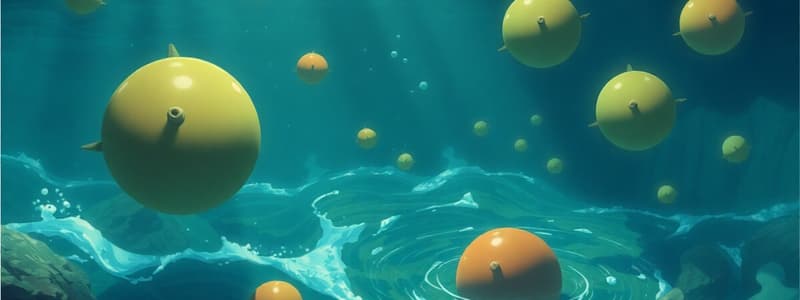Podcast
Questions and Answers
Which of the following best describes buoyancy?
Which of the following best describes buoyancy?
- The upward force exerted on an object submerged in a fluid (correct)
- The weight of an object
- The density of an object
- The pressure at the bottom of an object submerged in a fluid
A ship floats on water due to the principle of ______, where the upward buoyant force counteracts the ship's weight.
A ship floats on water due to the principle of ______, where the upward buoyant force counteracts the ship's weight.
buoyancy
What are the main causes of oil spills?
What are the main causes of oil spills?
Oil spills can be caused by accidents during transportation, drilling, or refining of oil, as well as natural events like earthquakes or hurricanes.
Pneumatic systems use liquids as the working fluid, while hydraulic systems use compressed air.
Pneumatic systems use liquids as the working fluid, while hydraulic systems use compressed air.
Match the following fluid concepts with their definitions:
Match the following fluid concepts with their definitions:
Flashcards
Buoyancy
Buoyancy
The upward force exerted by a fluid on an object immersed in it.
Oil Spills
Oil Spills
The release of liquid petroleum hydrocarbons into the environment, particularly marine areas.
Why Ships Float
Why Ships Float
Ships float due to buoyancy, which counteracts gravity, because their shape displaces enough water.
Pneumatic Systems
Pneumatic Systems
Signup and view all the flashcards
Pressure in Fluids
Pressure in Fluids
Signup and view all the flashcards
Study Notes
Buoyancy
- Buoyancy is an upward force exerted by a fluid that opposes the weight of an immersed object.
- This force is due to the difference in pressure between the top and bottom of the object.
- The pressure at the bottom of an object submerged in a fluid is greater than the pressure at the top.
- Archimedes' principle states that the buoyant force on an object is equal to the weight of the fluid displaced by the object.
- If the buoyant force is greater than the weight of the object, the object will float.
- If the buoyant force is less than the weight of the object, the object will sink.
- Buoyancy is crucial for objects floating in liquids or gases.
Oil Spills
- Oil spills occur when a large amount of oil is released into the environment, usually into water bodies.
- Common sources of oil spills include accidents in oil tankers, offshore drilling platforms, and pipelines.
- Oil spills have significant detrimental effects on marine ecosystems.
- Oil coats and damages the feathers of seabirds, leading to hypothermia and inability to fly and hunt.
- Oil can kill marine animals or affect their ability to reproduce, impacting food webs and populations.
- Oil spills can also harm coastal habitats and shorelines, including plants, invertebrates and other organisms.
- Oil dispersants are sometimes used to break down the oil, to prevent its spread.
- Cleanup efforts often involve skimming the oil from the surface or using other physical methods to remove it.
Why a Ship Floats on Water
- A ship floats because the buoyant force acting on the ship is greater than or equal to the weight of the ship when it is fully submerged.
- The shape of a ship is designed to displace a large volume of water.
- The volume of water displaced by the ship generates an upward buoyant force.
- The weight of the ship acts downwards.
- The ship's hull is designed to have a large displacement volume, enabling the upward force to be at least equal to the weight of the ship.
Pneumatic and Hydraulic Systems
- Pneumatic systems utilize gases, primarily air, to transmit force.
- Hydraulic systems utilize liquids, typically incompressible fluids like oil, to transmit force.
- Both systems rely on principles of pressure and fluid mechanics.
- Pneumatic systems are often used for simple operations like opening doors or controlling small machines.
- Hydraulic systems are commonly used for heavy-duty operations, such as operating large machinery and hydraulic jacks.
- Pneumatic systems are generally less efficient than hydraulic systems for transmitting significant force over long distances.
- Pneumatic systems are generally more susceptible to leaks, as liquids are more difficult to contain.
- Pressure is exerted equally in all directions within a fluid.
Pressure in Fluids
- Pressure in fluids is defined as force per unit area.
- Fluids exert pressure in all directions, not just downwards.
- Pressure increases with depth in a fluid.
- Denser fluids exert greater pressure.
- The pressure exerted by a fluid at any given point depends only on the depth and density of the fluid.
- Pascal's principle states that a change in pressure at any point in an enclosed fluid will be transmitted equally to all parts of the fluid.
- Pressure differences in a fluid can cause fluid to flow from one point to another.
- The principle of pressure in fluids is crucial to the operation of hydraulic and pneumatic systems.
Studying That Suits You
Use AI to generate personalized quizzes and flashcards to suit your learning preferences.




